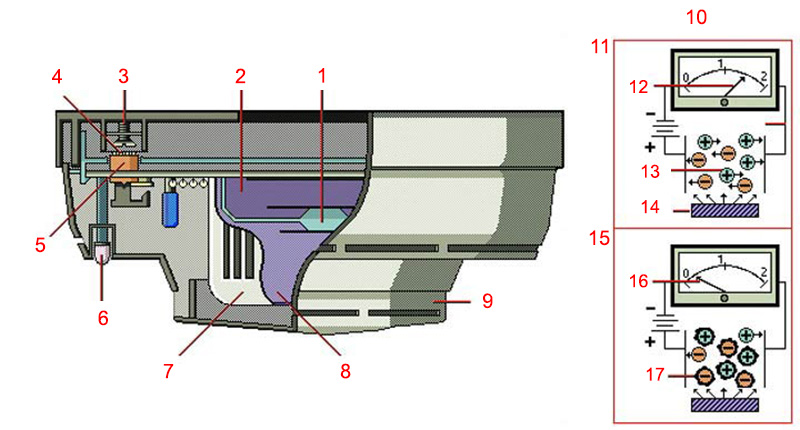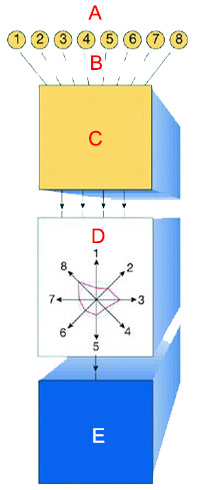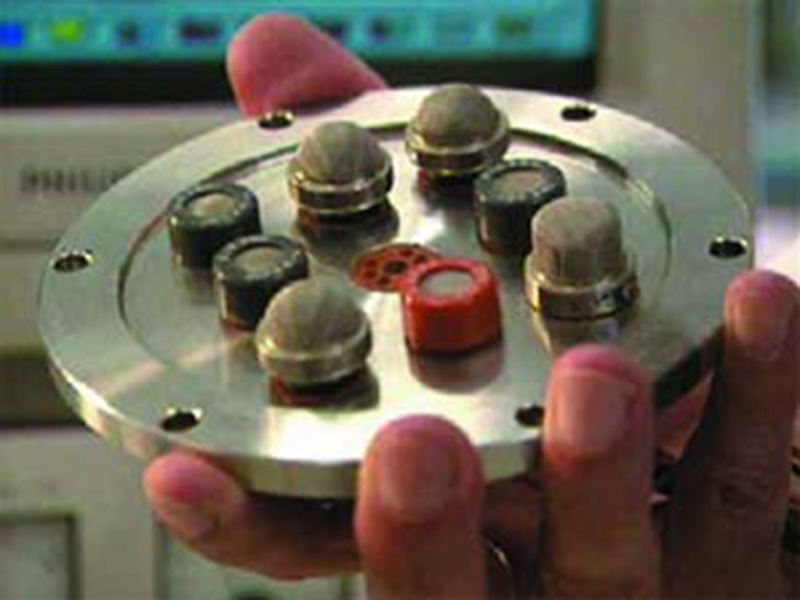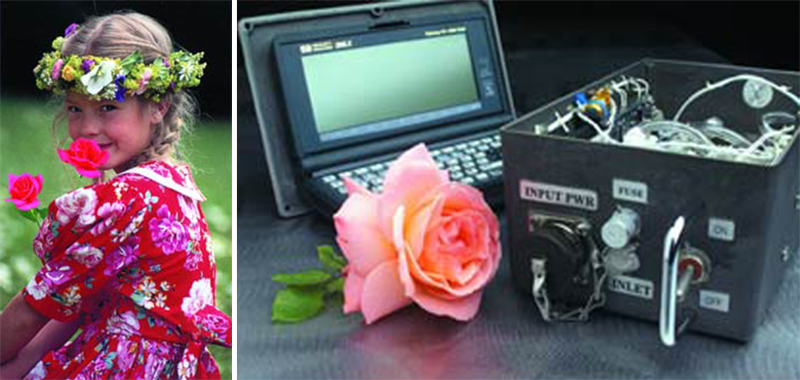Technology in the Olfactory System
Have you ever realized that your senses constantly warn you against possible dangers from your surroundings? As you cross the road, for example, if you hear the horn of a car approaching at high speed, you immediately glance in the direction of the sound and thus avoid an accident that might otherwise be fatal.
Some dangers, however, are beyond the scope of sight and hearing. In some situations, the sense of smell successfully performs a warning function. Of all the potential hazards in your home, you can detect a gas leak, for example, only through your sense of smell. The first sign of a fire beyond your field of vision is the smell of smoke. People with weak or non-existent senses of smell are defenseless in the face of such situations.
Certain electronic devices have been developed to warn against such dangers. In the designing them, the human sense of smell was taken as the model. For example, gas or fire detectors produced along these lines are just crude imitations of the nose.
Fire Detectors
As you know, fire detectors react to smoke particles in the air and emit a warning alarm. Consider the models that work according to the principle of ionization. (Figure 20) These devices contain a special detection compartment filled with ions—electrically charged particles. So long as clean air enters the device, these particles’ electrical charge remains stable. In the event that smoke enters, however, the ions are neutralized and the flow of electrical current is reduced. The drop in the current sets off a buzzer or other alarm.105
The special compartment in these electrical devices can be compared to the scent-receptor cells in the nose. You have already seen how the electrical charge in the receptor cell changes as a result of complex processes, and how a specific message thus emerges. The mechanism in a smoke detector is a rather primitive model of the perception system in the scent-receptor cells. Also, the difference between a fire detector and the human nose is far greater than that between a spacecraft and an oxcart.
 | ||
| 1. Radioactive Source | 7. Perception Area-Casing | 13. Ionized Particle |
| (Figure 20) The picture shows the comparatively complex structure of a smoke detector. The system in scent perception cells, however, is far more complex than this. | ||
"The Electronic Nose"
 |
| A. Standard Electronic Nose |
| (Figure 22) The functioning system of the electronic nose |
The human olfactory system can distinguish some 10,000 different odors. A professional in the perfumery business is able to smell a perfume that has a 100 different odorants in it, and list the ingredients.106 This superior creation in the human nose has encouraged numerous scientists to design similar apparatuses and various research and development centers worldwide are trying to reproduce the marvelous scent-perception system in human beings. One model developed along these lines is known as “the electronic nose.”
Instead of the human nose's receptors, made of proteins, its electronic equivalents employ a series of chemical receptors. (Figure 21) Each of these receptors is designed to detect a specific scent; as their selective capabilities increase, production of the devices grows more difficult and their prices rise. The sensors gather signals from their surroundings, turn them into binary codes by means of electronic systems, and send them to a computer. Electronic systems may be compared to the nerve cells in the olfactory system, and the computer itself as an imitation of the human brain. The computer is programmed to analyze data transmitted to it, thanks to which it interprets the signals in binary code. (Figure 22)
Electronic noses developed in this way are used in various sectors, especially the food, perfume and chemical industries and medicine. Universities and international organizations provide major backing for such projects. Nonetheless, as stated by Julian W. Gardner of Warwick University, “We're at the early stages of the technology”107
A Comparison of the Human and Electronic Noses
Scientists say that there no equivalent to the perception capacity of the scent-sensitive cells in the nose. 108 Furthermore, some researchers openly state the impossibility of developing an electronic device that can fully duplicate the human nose. Edward J. Staples, an expert in electronic sensor technology, is one who openly admits this. 109 Another scientist, Professor W. James Harper, says, “An electronic nose is not a replacement for people—it is a supplement”110 emphasizing that the electronic nose can only be an adjunct.
His statement may be expressed by an analogy: A camera cannot replace the eye, only support it. The relationship between the human nose and its electronic counterpart is much the same.
George Aldrich, chemical specialist at NASA, stated in the 23 June, 2001, edition of New Scientist magazine that nothing could surpass the human nose. When asked why NASA did not use electrical equipment in olfactory tests, Aldrich’s replied;
... in my opinion, they don't come anywhere close to the range of the human nose. There's nothing better than the human nose.111
 |
Leaving aside these facts for the moment, let us compare the two models, to once again reveal the superiority of creation in the human nose:
1) Electronic noses are able to detect only a limited number of odors, rather than the thousands that the human nose can.
2) Computer-supported electronic noses are much larger compared to the human nose and are delicate devices, requiring intense care and maintenance. Moreover, the short lives of sensors represent another major problem. 112 Our scent-perception system, on the other hand, never requires any maintenance during a lifetime of operation.
3) The cost of a single electronic nose can be as much as $100,000.113
4)In the human nose, the scent-perception process is completed in as little as less than a second. Analysis lasts for minutes in the electronic counterpart, however. 114
5) Adjustment of the sensors and programming the computers to which they are linked are particularly important. Research has shown that high levels of water, alcohol, carbon dioxide and acetic acid can impair the device’s sensitivity. 115 In addition, scent experts need to program the electronic nose very carefully, or else certain odors may cause the device to give incorrect or uncertain results.
6) Any system composed of sensors and computers lacks any mechanism for making logical judgments. Yet human beings carry out this process from a very young age. As soon as a baby is born, it can recognize its mother from her smell, and can distinguish between odors two days later. 116
7) Despite the advanced technology of the present day, no electronic device with the capacity of the human nose can be manufactured, showing just how astonishing the design of our scent-perception system truly is. Experts working on the subject of the electronic nose are better aware of this than most other people.
 |
| (Figure 21) Some sensors used in the electronic nose. These sensors were designed under inspiration from the receptors in the human nose, but are incomparably more primitive than the receptors in the human nose. |
This scent-perception system has been functioning perfectly since the creation of the first human being. Yet the structure is so complex that the details of the scent-receptor working mechanism and the perception system in the brain are, to a large extent, still not understood. Indeed, less is known about the olfactory system than about sight, hearing and touch. 117 Therefore, any electronic system to replace the human nose is clearly wishful thinking.
Apparently more advanced electronic noses will be produced in years to come, but that does not change this manifest truth: An electronic nose cannot emerge by chance, but is the product of specific planning, programming and design. Similarly, the nasal and scent systems, so superior to their electronic counterparts, did not come into being spontaneously or by chance. They are proofs of the superior artistry of God, the infinitely loving and merciful. And the way they have been placed at the service of all living things is a great blessing.
In short, every new scientific discovery regarding the human body and the scent perception system will once again inflict major disappointment on those who insist on propounding evolution. At the same time, such advances will help us to obtain a better idea of God’s infinite knowledge and intellect. This will enable believers to draw closer to Him, to better appreciate His might, and to increase their fear of Him.
 |
| The electronic nose is far more primitive than the human nose, despite all the technology it employs. |
Believers’ attitudes in the face of God’s verses have been revealed in the Qur’an:
In the creation of the heavens and the Earth, and the alternation of night and day, there are Signs for people with intelligence: those who remember God, standing, sitting and lying on their sides, and reflect on the creation of the heavens and the Earth: "Our Lord, You have not created this for nothing. Glory be to You! So safeguard us from the punishment of the Fire." (Surah Al 'Imran: 190-191)
Footnotes
105. “Fire Fighting,” M. Encarta Encyclopedia 2000. ![]()
106. Elise Hancock, “A Primer on Smell,” Johns Hopkins Magazine, September 1996. ![]()
107. Mia Schmiedeskamp, “Plenty to Sniff At,” Scientific American, March 2001; http://www.sciam.com/2001/0301issue/0301techbus1.html. ![]()
108. Philip Morrison, “The Silicon Gourmet,” Scientific American, April 1997; http://www.sciam.com/0497issue/0497wonders.html. ![]()
109. Mia Schmiedeskamp, Op cit. ![]()
110. Pam Frost, “Electronic Nose Inspects Cheese, Hints at Human Sense of Smell,” The Ohio State University Research News, 30/9/1998, http://www.acs.ohio-state.edu/units/research/archive/nosetron.htm. ![]()
111. “Nose Jop, "New Scientist Magazine, 23 June 2001, pp. 44-47. ![]()
112. W. James Harper, “Strengths and Weakness of the Electronic Nose,” http://www.fst.ohio-state.edu/FS/nose/sld024.htm. ![]()
113. Pam Frost, Op cit.; http://www.acs.ohio-state.edu/units/research/archive/nosetron.htm. ![]()
114. Philip Morrison, “The Silicon Gourmet,” Scientific American, April 1997, http://www.sciam.com/0497issue/0497wonders.html. ![]()
115. W. James Harper, “Strengths and Weakness of the Electronic Nose,” http://www.fst.ohio-state.edu/FS/nose/sld026.htm ![]() .
.
116. “Infancy,” M. Encarta Encyclopedia 2000. ![]()
117. Pam Frost, Op. cit., http://www.acs.ohio-state.edu/units/research/archive/nosetron.htm. ![]()
- Introduction
- The Creation in the Olfactory System
- Mechanisms within the System
- What Odors and the Olfactory System Suggest
- Animals' Sense of Smell
- Evolutionists Cannot Account for the Origin of the Sense of Smell
- Technology in the Olfactory System
- The Perfect Creation in the Taste System
- Conclusion
- The Deception of Evolution
